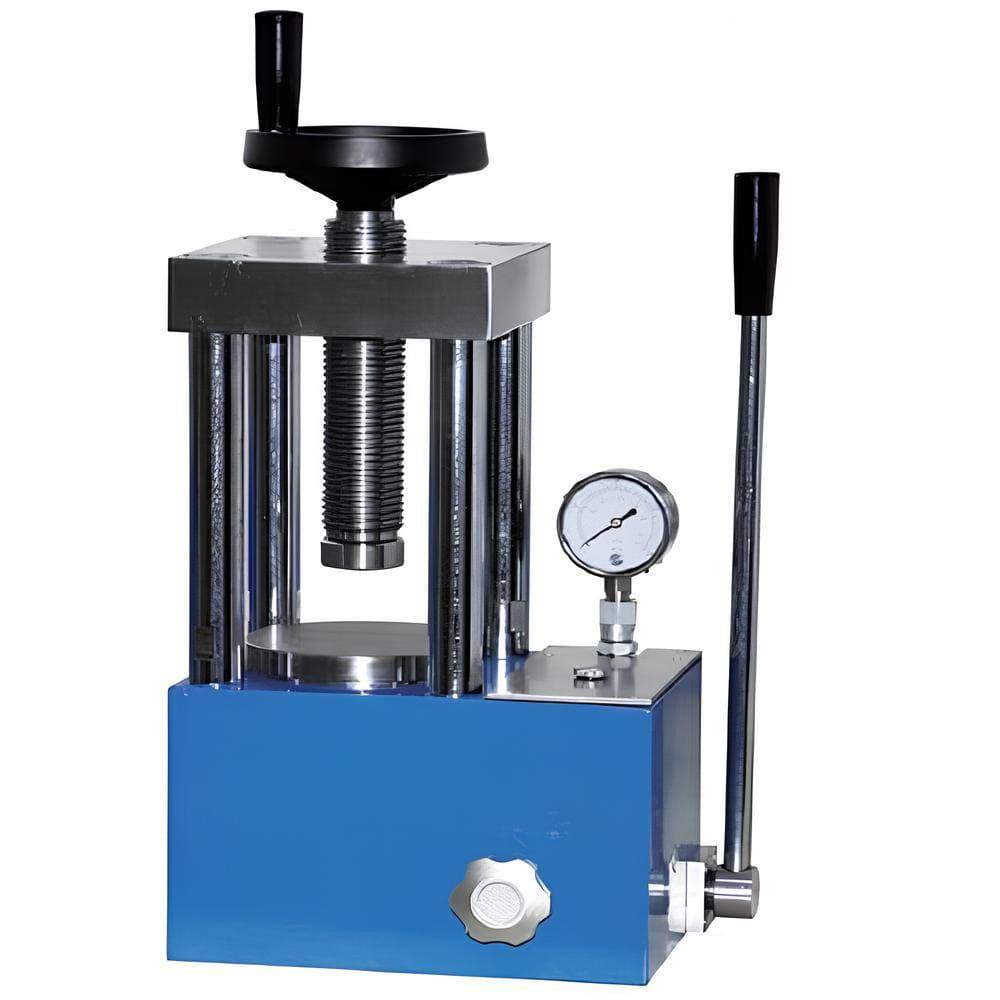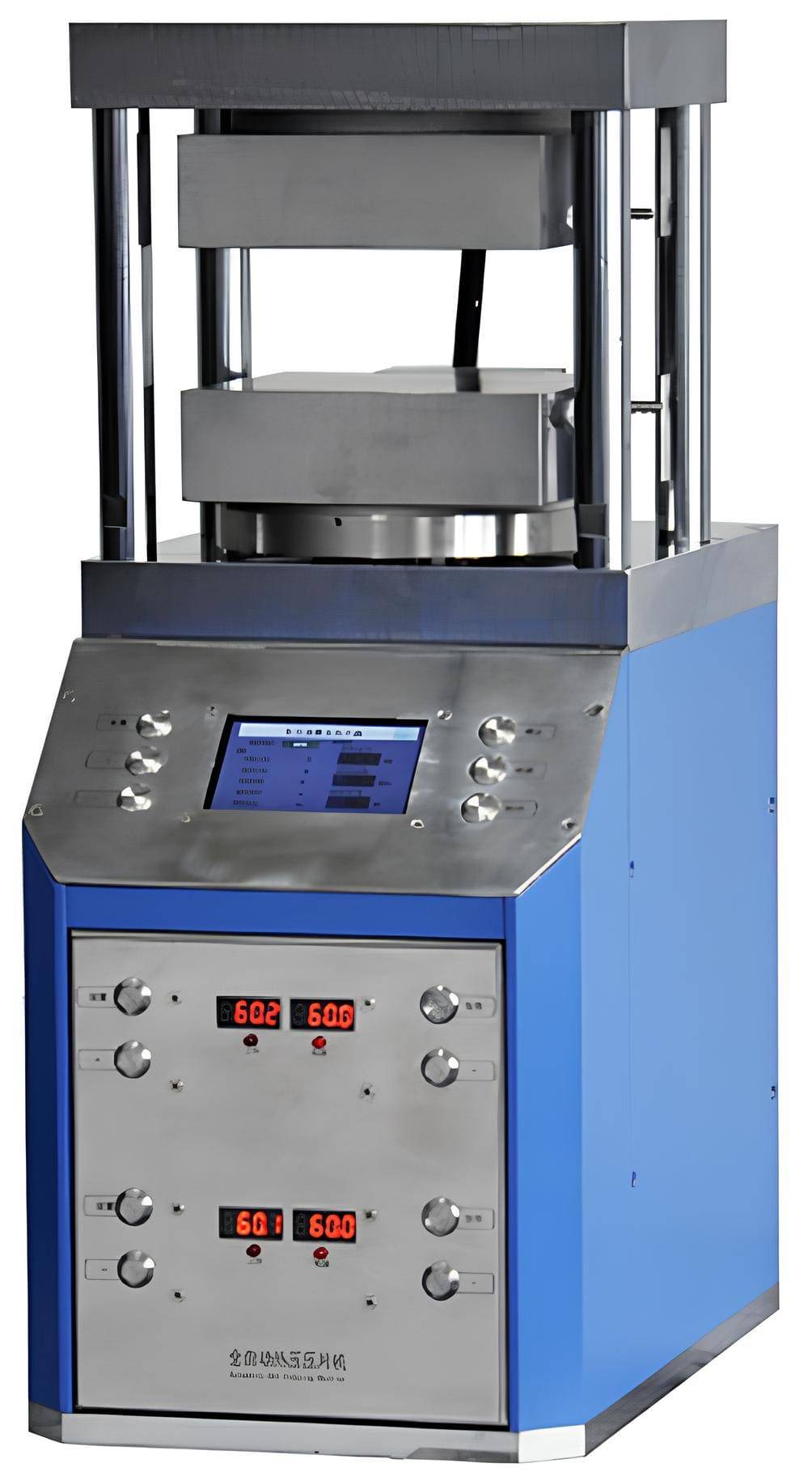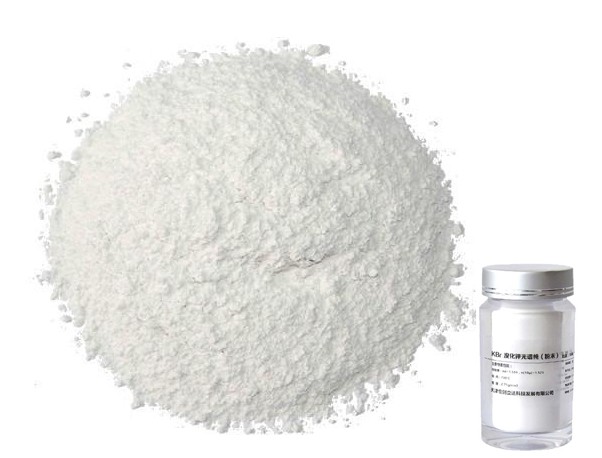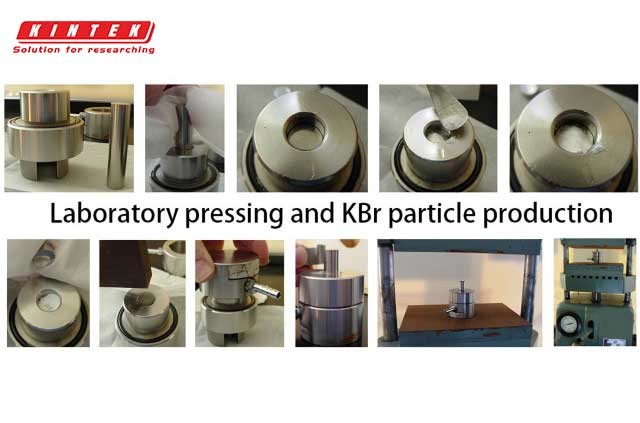Introduction
Table of Contents
In the world of scientific research and analysis, laboratory presses and KBr pellet production play a crucial role. These tools are essential in the preparation of samples for various analytical techniques, such as infrared spectroscopy and XRF spectroscopy. Laboratory presses, including hand presses and hydraulic presses, offer unique benefits and drawbacks. Understanding the necessity of using hydraulic presses for large-scale KBr pellet production is crucial for efficient and accurate results. Additionally, following specific guidelines for KBr pellet production ensures the quality and reliability of the samples. Let's dive deeper into the world of laboratory presses and KBr pellet production to unravel their importance and applications.
Benefits and Drawbacks of Hand Presses
Advantages of hand presses

Manual Tablet Presses
Operating a manual hydraulic press is a relatively simple process, but it is important to exercise caution when using this type of equipment. It’s vital to always make sure that the area around the press is clear before starting any operation, and to always follow safety instructions when using hydraulic machinery.
Cost-effectiveness
For some labs, manual hydraulic presses present an advantage over automatic equivalents. This is mostly due to price; if you aren’t paying for electronically powered equipment, you’ll likely be paying less.
Infrequent use
Whether you’ll get value out of a manual hydraulic press depends largely on how often it will be used. If you don’t use a press frequently, operating it by hand isn’t likely to cause much inconvenience.
Workflow consideration
When you consider if a manual hydraulic press will suit your laboratory operations, it’s best to review your workflow. Manual presses require more physical effort to operate than an automatic equivalent – so if your technicians will need to use them often, it can become labour-intensive work.
Cost-effective addition
However, for infrequent use, a manual press can be a cost-effective addition to your laboratory set-up.
Disadvantages of hand presses
Lack of repeatability
A manually operated press is also harder to use in a repeatable fashion, with every sample being pressurized to a slightly different load by the operator.
Physical effort
Manual hydraulic presses require more physical effort to use compared to automatic counterparts. This can be a drawback if technicians need to use them frequently.
Automatic Hydraulic Press

Automatic Hot Presses
An automatic hydraulic press uses an electric motor to drive the pump and electric switches to open and close the relief valve. This means they can be controlled to a high accuracy and repeatability.
Precision and repeatability
Unlike a manual press, the piston in an automatic hydraulic press is controlled by a switch or automated controller. This allows for incredibly precise application of force, and the pressure will be the same every time.
Cost and physical effort
There are no electronic components in a manual hydraulic press, and as a result, this machine is often cheaper than its automatic counterparts. However, they require more physical effort to use, and there's always a chance that samples are being pressurized to a slightly different load by the operator.
Necessity of Hydraulic Press for Large Amount of KBr Pellets
If you are doing briquetting for XRF, the answer is yes–there is no alternative. If you are doing KBr pellets, you should first consider a hand press.
Hand presses make excellent transparent KBr pellets with minimal work. They require virtually no lab space and they are portable. Furthermore, they are relatively easy to operate.
The major drawbacks of hand-operated presses are that they do not lend themselves well to creating samples that can be stored for future reference and they are either not evacuable or cannot be evacuated with the efficiency of a die set designed for a hydraulic press. If you keep your powder dry and your anvils heated, water absorbances can be minimized. Extra collars for hand press die sets can solve short term pellet storage needs.

But, if you are going to make a large number of KBr pellets that must be very dry or that you intend to store in large quantities, you will need a hydraulic press.
A benchtop KBr Pellet Press provides a convenient and economical means for compressing powdered materials into pellet form without incurring the cost normally associated with expensive laboratory presses and pellet dies. It is a compact, hand-operated press that can be used anywhere in the laboratory, requiring very little bench space and no fixed mounting.
The KBr Pellet Press produces uniform pellets in a polished die and ejects them smoothly into a receiver without incident of contamination. The pellets produced are cylindrical in shape with flat ends. Their height or thickness depends upon the amount of material compressed and the force applied.
The dies of the KBr Pellet Press are not fastened down. They automatically align with the press ram and may be slipped out from under the ram for quick reloading.
Guidelines for KBr Pellets Production

KBr Particle Production Process
Preparation before making pellets
Before starting the process of making KBr pellets for XRF analysis, there are a few key considerations that need to be taken into account. These include:
-
Temperature uniformity requirements: The temperature uniformity plays a crucial role in the pelletising process. The smaller the temperature uniformity, the better the temperature uniformity is. It is recommended to consult the technical personnel of the manufacturer to determine the appropriate temperature uniformity for your specific needs.
-
Maximum temperature requirement: The sintering effect depends on the temperature. Different temperatures have different requirements for the production process. The higher the temperature, the more complex the production process and requirements are, and the more expensive the price is.
Importance of using dry KBr powder
Using dry KBr powder is essential for producing high-quality pellets. KBr is hygroscopic, meaning it will start to absorb water from the air as soon as you open the bottle. Moisture in the KBr powder can affect the FTIR measurement. To keep the KBr powder dry, it is recommended to heat the anvils and the body of the die set before making the pellets. Storing the KBr powder in a heated case or desiccator can also help in keeping it dry. If keeping the KBr powder dry is challenging, grinding your own powder from random cuttings of KBr can be a viable solution.
Temperature uniformity
Temperature uniformity is crucial in the pelletising process. The better the temperature uniformity, the higher the cost. It is important to ensure that the anvils, die set, and powder are all at the same temperature. Hot powder and cold anvils can result in a cloudy wet pellet. Maintaining temperature uniformity can be achieved by heating the anvils and die set before making the pellets.
Reducing moisture in KBr powder
Moisture in the KBr powder can negatively impact the quality of the pellets. To reduce moisture, it is recommended to heat the KBr powder in a dry environment. Storing it in a heated case or desiccator can help in keeping it dry. If moisture absorption is a persistent issue, grinding your own powder from random cuttings of KBr can be a solution.
Avoiding excessive use of KBr powder
Using excessive amounts of KBr powder is a common mistake in pellet production. It is important to use as little KBr powder as possible, usually just enough to coat the anvils of the die set. Excessive powder requires more force during the pressing process and can result in wedged pellets or white spots. It is recommended to grind the sample, not the KBr powder, and mix the sample into the KBr powder instead of grinding it.
Mixing technique for the sample and KBr powder
When mixing the sample and KBr powder, it is important to not grind the KBr powder. Grinding the KBr powder can open crystal facets that absorb moisture. Instead, mix the sample into the KBr powder without grinding it. This will help maintain the quality of the KBr powder and prevent moisture absorption.
Ensuring proper assembly and condition of the die set
If you are using a vacuum die set, it is crucial to ensure that it is properly assembled and that the seals are in good condition and positioned correctly. This will help maintain the vacuum and prevent any leaks during the pelletisation process. Detailed pellet making instructions applicable to specific accessories are available with all ICL presses and dies.
By following these guidelines and taking into consideration the factors mentioned above, you can ensure the production of high-quality KBr pellets for XRF analysis. Remember to keep the KBr powder dry, use the appropriate amount of powder, and mix the sample and KBr powder without grinding the KBr powder.
Applications of Laboratory Presses

X-ray Fluorescence (XRF) Spectroscopy
Uses in infrared spectroscopy
Laboratory presses are widely used in the field of infrared spectroscopy for various applications. One of the common uses is for the preparation of sample pellets for Fourier transform infrared spectroscopy (FTIR). This involves creating KBr (potassium bromide) pellets, which are used to hold the sample being analyzed. The laboratory press applies pressure to compact the KBr and the sample together, allowing for accurate analysis of the chemical bonds and vibrations in the sample.
In addition to the KBr pellet method, laboratory presses are also used for other measurement methods in infrared spectroscopy, such as the diffuse reflection method and attenuated total reflection method. These methods are selected based on the sample form, and laboratory presses play a crucial role in preparing the samples for analysis.
Applications in XRF spectroscopy
Laboratory presses are essential for sample preparation in X-ray fluorescence (XRF) spectroscopy. XRF is a powerful elemental analysis tool used to identify and quantify elements in a bulk material non-destructively. To achieve accurate results, XRF samples need to be properly prepared.
Laboratory presses are used to create pressed pellets for XRF analysis. This process involves pressing a mixture of the sample and a matrix material, such as KBr or an organic binder, into a pellet. The laboratory press applies pressure to compact the mixture, ensuring a homogeneous sample for analysis. Pressed pellets are widely used in various industries, including cement, mining, and industrial minerals, for quality control of raw materials and finished products.
Pressing thin polymer films

Compression of polymer films
Laboratory presses are also used for pressing thin polymer films. These films are used in a wide range of applications, including memory chips, solar cells, electronic devices, and more. Laboratory presses with heated platens are used to apply pressure and heat to the polymer films, allowing for precise control of conformance and coating thickness.
The deposition techniques used for creating thin polymer films include chemical vapor deposition (CVD) and various coating methods. Laboratory presses play a crucial role in the fabrication process, ensuring uniformity and quality of the thin polymer films.
Other applications
Laboratory presses have numerous other applications beyond infrared spectroscopy and XRF spectroscopy. Some examples include:
- Aerospace industry
- Architectural ironmongery, panels, and sheets
- Automotive industry
- Dyes and molds
- Firearms
- Optics
- Watches
- Jewelry
- Thin film applications (window tint, food packaging, etc.)
![Applications aerospace wood automotive food packaging coloring etc.]()
Applications aerospace wood automotive food packaging coloring etc.
Laboratory presses are versatile and can be used for various tasks, such as pill making and laminating. They are valuable tools in many industries and research fields, providing the means to apply pressure and compact materials for different purposes.
In summary, laboratory presses have wide-ranging applications in different fields, including infrared spectroscopy, XRF spectroscopy, and pressing thin polymer films. These versatile tools play a crucial role in sample preparation, ensuring accurate and reliable analysis of materials. Whether it's creating sample pellets for spectroscopy or pressing thin films for electronic devices, laboratory presses are essential for achieving high-quality results.
Conclusion
In conclusion, laboratory presses and KBr pellet production play a crucial role in various scientific applications. The benefits of hand presses, such as their affordability and portability, make them suitable for small-scale operations. However, for large quantities of KBr pellets, a hydraulic press is necessary to ensure efficiency and consistency. Following the guidelines for KBr pellet production, including proper preparation, temperature control, and mixing techniques, is essential for obtaining high-quality pellets. Laboratory presses have diverse applications in infrared spectroscopy, XRF spectroscopy, and pressing thin polymer films, among others. Overall, these tools are invaluable in scientific research and analysis.
If you are interested in this product you can browse our company website:https://kindle-tech.com/product-categories/heated-lab-press, as an industry-leading laboratory equipment manufacturer, we are committed to providing the most advanced and high-quality laboratory equipment solutions. Whether you are engaged in scientific research, teaching or industrial production, our products will meet your needs for accurate and reliable laboratory equipment.
Related Products
- kbr pellet press 2t
- Automatic Laboratory Hydraulic Press for XRF & KBR Pellet Press
- Laboratory Hydraulic Pellet Press for XRF KBR FTIR Lab Applications
- Automatic Laboratory Hydraulic Pellet Press Machine for Lab Use
- Heated Hydraulic Press Machine with Heated Plates for Vacuum Box Laboratory Hot Press
Related Articles
- Manual Hydraulic Pellet Press: An Efficient Tool for Spectral Analyses Preparation
- Automated laboratory XRF and KBR pellet press operating procedures
- Exploring the Benchtop KBr Pellet Press: Features, Mechanism, and Applications
- Choosing the Right Lab Press: A Comprehensive Guide
- The Benchtop KBr Pellet Press: An Efficient Tool for Laboratory Use




















